#also really want to do an analysis of the parallels between her and daphne and marina during season one
Explore tagged Tumblr posts
Text
Siena and her opera performances - a short character study
So, I thought I might share a short little analysis of the operas Siena performed, as I’ve not seen anything like this on here before and I’ve spent some time digging into those operas for my fanfics.
I want to post a whole character analysis of Siena at some point, but the operas play an important part in highlighting Siena’s character and her relationship with Anthony, so I thought it might be interesting to dig a bit deeper into those performances. Especially when it comes to a character like her (who barely got any screentime), those few seconds of her performing make a nice addition and add some depth to her character and storyline.
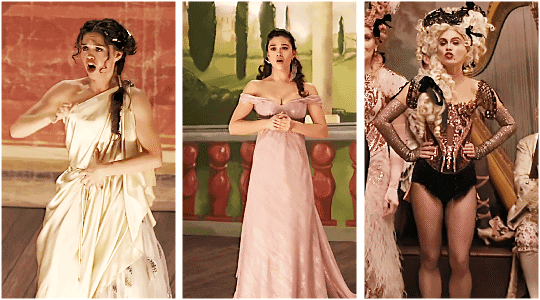
I won't focus much on the opera Siena performs in episode 1 – Gluck’s Iphigénie en Tauride – as it's not as interesting as the other two, because there doesn’t seem to be much of a connection to Siena’s character or her relationship with Anthony per se. Unlike the other operas, the focus in this scene is clearly not on her – she’s mostly just in the background, with two very short closeups, so we see that it’s her that is performing on stage. There is a deleted scene between her and Anthony according to the published script of that episode:
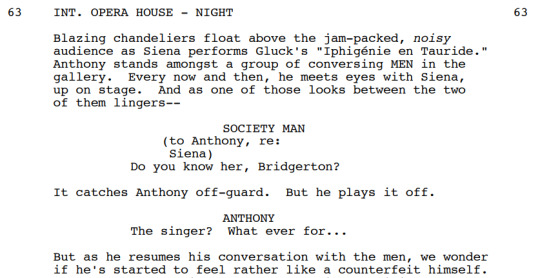
However, while I think that deleted scenes and such can make for interesting footnotes during an analysis/interpretation, I don’t like taking them too much into consideration – after all, there might be a good reason why this was deleted.
So the actual scene we see doesn’t really highlight anything in regards to Siena’s characters besides the fact that she’s an opera singer and that this is one of the only times we see her wear some brighter colors – while she’s on stage, playing a character. The other two operas she performs in episode 3 and 4 are much more focused on her character and storyline, especially her performance of I Capuleti e i Montecchi in 1.03 – this is the only time we see her perform without any of the other cast members present.
However, that’s not the only difference between Iphigénie en Tauride and the other operas. I Capuleti e i Montecchi and Les contes d'Hoffmann are also anachronistic. Iphigénie en Tauride premiered 1779, while I Capuleti e i Montecchi premiered in 1830 and Les contes d'Hoffmann in 1881.
People tend to make fun of historical inaccuracies or dismiss them as mistakes, but most times, anachronism is on purpose. I think it’s safe to assume that everyone working on this has been aware that those operas would not premiere until decades after season 1. The operas were clearly chosen for a reason.
Les contes d'Hoffmann by Jacques Offenbach (1881)

Les contes d’Hoffmann (The Tales of Hoffmann) tells the story of Hoffmann, who choses to give up on love and devotes his life to art and poetry instead. It's based on three short stories by E. T. A. Hoffmann, and some are probably familiar with the movie, but just to roughly summarize (also because there’s some important differences): At the beginning of the story, a prima donna named Stella invites Hoffmann to a meeting in her dressing room after her performance. Before the meeting, Hoffmann recounts his past great loves to his students. The opera consists of three acts, each telling the story of one of Hoffmann’s previous loves. After recollecting his stories of heartbreak, The Muse can convince Hoffmann to give his love to her (poetry) instead of visiting Stella.
There are many parallels to Siena and her relationship with Anthony here. The most obvious one is the prima donna part – Stella represents Siena. While there might not be direct similarities within the story or between Anthony and Hoffmann, the ending to Hoffmann’s story is still in some parts similar to Anthony’s. The opera ends with Hoffmann declaring that he doesn’t want to love anymore – which sounds quite similar to what Anthony says at the end of season 1.
Siena is obviously not performing the entire opera – we only see her sing “Belle nuit, ô nuit d'amour” as the courtesan Giulietta – who tries to fool Hoffmann into falling in love with her.
Storytelling-wise, it obviously does not fit Siena’s story at this point – she is not trying to fool Anthony into falling in love with her, quite the opposite. Though it does work well as a juxtaposition, especially when we see Siena noticing Anthony’s stares and she slips out of her role. There’s a clear contrast here between her performing as a devious courtesan and looking almost flustered as a result of Anthony’s gaze.
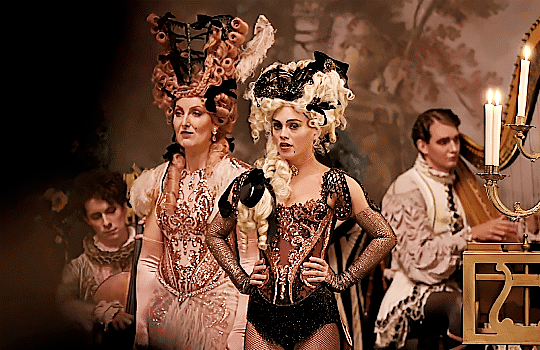
And although Siena at that point doesn’t want to seduce Anthony in any way, the piece still beautifully represents the actual scene that takes places here: Anthony longingly staring at her the very moment he recognizes her voice – almost as if under a spell (a very horny spell). Even when Violet tries to distract him, he cannot help but look in Siena’s direction. He’s completely enthralled by her here – similarly to how Hoffmann was enthralled by Giulietta. And similarly, both relationships are doomed to end unhappily.
Adding onto that, this is also the only time that we see Siena on stage where she represents exactly who she is: a courtesan. During the other two performances, she’s wearing bright, pastel gowns – very different from her usual style. The costume she wears here is also different from her usual style, which is fairly plain otherwise – but it does highlight the role she plays within society.
I find it quite interesting that this is the only time we see Anthony and Siena interact with one another during one of her performances – and one of the only times we see them interact in public altogether. This scene clearly shows the class difference between them: Anthony attending a ball as the lord he is, while Siena performs for everyone else’s entertainment, playing a seductive courtesan. They are present at the same place, yet they can’t talk to one another – there is an invisible wall between them which is highlighted by the positions they take within that scene as well as the clothes they wear. Had Siena performed any other part of that opera, she would probably have worn a pretty gown and those differences would not nearly be as noticeable. But she’s performing as a courtesan and as a result, this might be the most visible representation of her and Anthony’s differences and main conflict.
Returning to the actual story of the opera: At the end, Hoffmann explains how his three previous loves – Olympia, Antonia and Giulietta – all represent Stella. They show different aspects of the prima donna: the musician, the young girl and the courtesan. As I said, Stella represents Siena, and so do all of the other characters. In this scene, we see her visually represented as the courtesan. The show highlights this several times, especially during episode 3 when she talks to Genevieve and then later visits the gentlemen’s club and is inviting Simon to join her the next evening. Her need to find a keeper that can protect her and provide for her plays an essential role within her storyline.
Then, she’s obviously also a musician – a good amount of her scenes consist of her performances, and her character is defined by those performances. And, in the end, she’s also a young girl – and the show ensures to highlight that part as well. Through showcasing her vulnerability and emotions, we can see that she is not that different from the other young women in the show, like Daphne and Marina. They are all young, dealing with heartbreak and making decisions to secure their future. And this is in my opinion what sets Bridgerton apart from other stories of its genre. Usually, a character like Siena would only be the musician and courtesan – either sidelined or vilified. The show humanizes her, however, by granting her screentime to show her pain and struggles and even, to some extent, her innocence – which is especially well done during her performance in 1.03.
I Capuleti e i Montecchi by Vincenzo Bellini (1830)
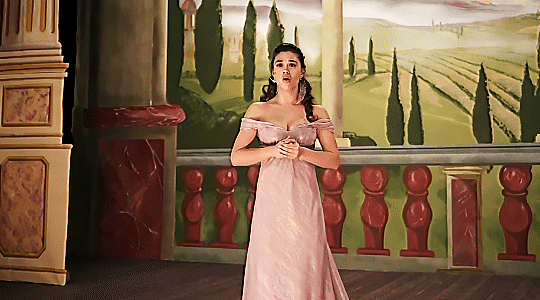
As you can probably guess by the title, I Capuleti e i Montecchi tells the story of Romeo and Juliet. I don’t think there’s a need to summarize the story, and I also think it’s pretty clear why this particular opera was chosen: Romeo and Juliet originated the star-crossed lovers trope – which is the exact trope Siena and Anthony would fall under.
There are many things I love about that scene – it’s just all around a brilliant scene, not just in relation to Siena’s character. Though I will obviously only focus on how it relates to her character here.
The aria Siena performs is “Oh! quante volte” – Juliet waiting for Romeo, begging for him to come for her. It’s quite emotional and allows for Siena’s character to express her own emotions throughout her performance.
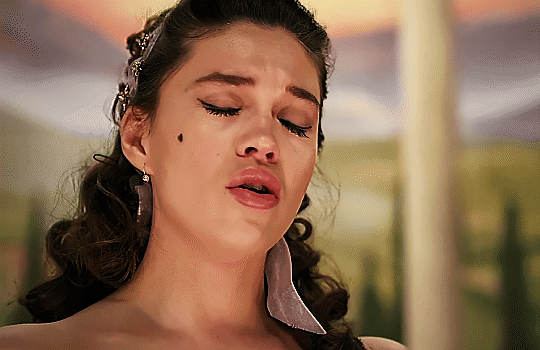
First, I adore how beautifully this ties in with the next scene. For one, because it sets up the atmosphere and essence of Siena and Anthony’s relationship – the tragedy of it all. The scene with Anthony in Siena’s dressing room underlines how this is not meant to be a love story with a happy ending, and the performance right before that amplifies this. Their story is doomed to end unhappily. And, similar to Romeo and Juliet, it is not merely a tragic story about love – it’s a story about the dangers of defying societal norms and duties and your own identities within that society.
But the dressing room scene also shows the clear differences between both stories. When Anthony visits her, Siena choses to reject him. She might have been emotional during her performance, but when Anthony showed his face, Siena did not act based on emotions but was very much rational in her words and actions. Because Anthony is not Romeo, and Siena is also not Juliet.
I also love how this performance builds a beautiful contrast to Les contes d'Hoffmann. Instead of a courtesan, Siena is playing an ingenue, wearing a pretty gown and looking all around sweet and innocent.
As the opera is in Italian, Juliet is obviously called Giulietta – just like the courtesan from Les contes d'Hoffmann. I have no idea whether this has been an accident or was done on purpose, but it’s a wonderful parallel. In both operas, she’s playing two very different women who happen to share the same name.
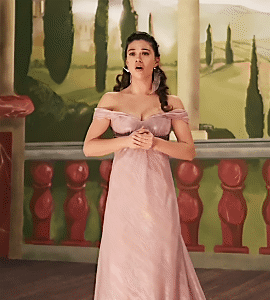
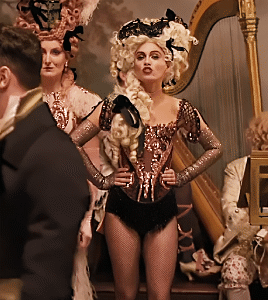
It underlines the differences between both roles but also draws a connection – which is Siena’s character.
By society, Siena is seen as the Giulietta from Les contes d'Hoffmann: the courtesan whose intentions are dubious and malicious. When Siena performs as I Capuleti e i Montecchi’s Giulietta, we can see a more vulnerable side of her as she openly cries on stage. We see her heartbroken and emotional, letting her guard down completely for a moment. In the end, it’s merely a performance. But Siena uses this performance to allow herself vulnerability – a vulnerability she is not usually allowed.
Those different performances do an excellent job at showcasing Siena’s character and also her main conflict and the different roles she plays. The chosen operas add some wonderful depth and insight into her character and I absolutely love how the shows has implemented them.
#bridgerton#siena rosso#anthony x siena#i have so many notes for analyses saved especially about siena#one day i will hopefully post that whole character study#also really want to do an analysis of the parallels between her and daphne and marina during season one#and i kinda want to dig a bit deeper into those operas too#there's definitely a lot more to focus on here#but i always need some time to actually write meta posts because I'm honestly fine just thinking about that stuff for myself#but sharing is fun too and makes for great discussions so i'm trying to post more#meta
23 notes
·
View notes